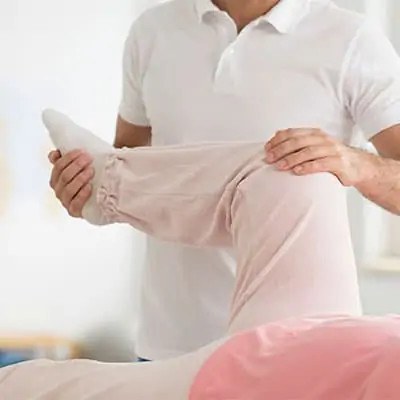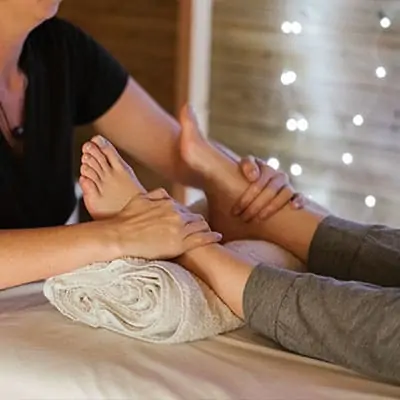At Cambridge Physiotherapy & Rehab, we offer efficient hip flexor strain treatment. Our skilled practitioners deliver personalized care for fast, safe recovery from hip flexor injuries.
Understanding Hip Flexor Strains
Hip flexor strains occur when one or more of the muscles that help move your hip forward are stretched or torn. These injuries can range from mild discomfort to severe pain and are common among athletes, dancers, and those with active lifestyles.
Causes of Hip Flexor Strains
- Overuse: Repetitive movements, especially in sports like running, soccer, or cycling, can lead to strain.
- Sudden Movements: Quick, explosive movements such as sprinting or jumping can cause tears in the hip flexor muscles.
- Inadequate Warm-Up: Engaging in strenuous activity without proper stretching or warm-up can increase the risk of strain.
- Muscle Imbalance: Weakness in the hip flexors or surrounding muscles can lead to compensatory strain and injury.
Symptoms of Hip Flexor Strains
- Pain and Discomfort: Typically felt in the front of the hip or groin area, pain can range from mild to severe.
- Swelling and Inflammation: Some individuals may notice swelling or bruising around the hip area.
- Reduced Mobility: Difficulty in leg movement, especially lifting the knee towards the chest.
- Weakness: A feeling of weakness in the hip area, making it hard to stand or walk.
Personalized Physiotherapy for Hip Flexor Strain
At Cambridge Physiotherapy & Rehab Center, we employ a multifaceted approach to treat hip flexor strains, focusing on reducing pain, promoting recovery, and preventing future injuries.
- Physiotherapy: Our physiotherapy programs are tailored to each individual’s specific needs, incorporating exercises that strengthen and stretch the hip flexor muscles, improve range of motion, and enhance overall mobility.
- Pain Management Techniques: We utilize various pain management techniques, including ice and heat therapy, to alleviate pain and reduce inflammation during the initial stages of recovery.
- Preventive Education: Our team provides valuable education on proper warm-up routines, stretching exercises, and lifestyle modifications to prevent re-injury and maintain hip health over the long term.
Other Services We Offer
At Cambridge Physiotherapy & Rehab Center, our commitment to your health extends far beyond hip flexor strain treatment. We offer a diverse array of services designed to meet your holistic health needs. Discover how we can support you across different aspects of wellness and rehabilitation:
- Physiotherapists
- Massage Therapy
- Orthotics
- Foot Care
- Scoliosis Treatment
- Rehabilitation for the Elderly
Why Choose Cambridge Physiotherapy & Rehab Center for Your Hip Flexor Strain Treatment?
Choosing Cambridge Physiotherapy & Rehab Center means opting for a team that understands the complexities of hip flexor strains and is committed to helping you achieve a full and speedy recovery. With our personalized treatment plans, state-of-the-art facilities, and a commitment to client education, we ensure that you receive the highest standard of care.
Don’t Let Pain Define Your Life
If you’re suffering from a hip flexor strain, don’t wait to seek treatment. Contact Cambridge Physiotherapy & Rehab Center in Cambridge today to schedule your consultation and take the first step towards getting back on your feet. Our team is ready to support you through every step of your recovery journey.
Don’t Let These Hip Conditions Keep You Down
|
|
Hip Flexor Strain Treatment Cambridge FAQs
What Is the Role of Ice and Heat in Treating a Hip Flexor Strain?
Ice and heat therapy can play a crucial role in the treatment of a hip flexor strain, each serving different purposes in the recovery process. Ice therapy is most effective in the initial stages after the injury, helping to reduce inflammation and numb pain. It’s typically recommended to apply ice for 15-20 minutes several times a day during the first 48-72 hours post-injury. Heat therapy, on the other hand, is beneficial after the initial acute phase, aiding in relaxing and loosening tissues and stimulating blood flow to the area, which promotes recovery. Heat can be applied in the form of a warm bath, heat packs, or a warm towel.
What Activities Should I Avoid During Recovery?
During the recovery from a hip flexor strain, it’s important to avoid activities that exacerbate the injury. This generally includes any movements that involve excessive stretching or contracting of the hip flexor muscles, such as running, jumping, or aggressive stretching exercises. High-impact sports and activities that involve sudden starts and stops should also be avoided until the muscle has recovered sufficiently. Your healthcare provider will give you specific guidance on which activities to avoid and suggest alternatives to maintain your fitness without risking further injury.
Can Hip Flexor Strains Lead to Long-Term Problems?
If not properly treated, a hip flexor strain can lead to chronic pain and persistent weakness in the hip area, potentially affecting your ability to perform daily activities and engage in sports or exercise. Additionally, inadequate rehabilitation or returning to full activity too soon after injury can increase the risk of re-injury or developing compensatory movement patterns, which may lead to issues in other areas of the body. Following a comprehensive treatment plan and adhering to the advice of healthcare professionals is essential to ensure a full recovery and minimize the risk of long-term problems.
How Can I Strengthen My Hip Flexors to Prevent Future Strains?
Strengthening the hip flexors, along with improving the overall balance and flexibility of the surrounding muscles, is key to preventing future strains. Exercises that focus on gradually building strength and flexibility in the hip flexors, such as leg lifts, lunges, and gentle stretching routines, can be beneficial. It’s also important to include exercises that strengthen the core and lower back muscles to support the hip area. Before starting any new exercise program, especially following an injury, consulting with a healthcare professional or physiotherapist is advised to ensure the exercises are appropriate for your specific condition and recovery stage.
Cambridge Physiotherapy & Rehab Center
895 Langs Dr Unit #2, Cambridge, ON N3H 5T6, Canada
(519) 219 5428
Hours:
Monday: 9 AM–5 PM
Tuesday: 9 AM–8 PM
Wednesday: 9 AM–5 PM
Thursday: 9 AM–8 PM
Friday: 9 AM–5 PM








